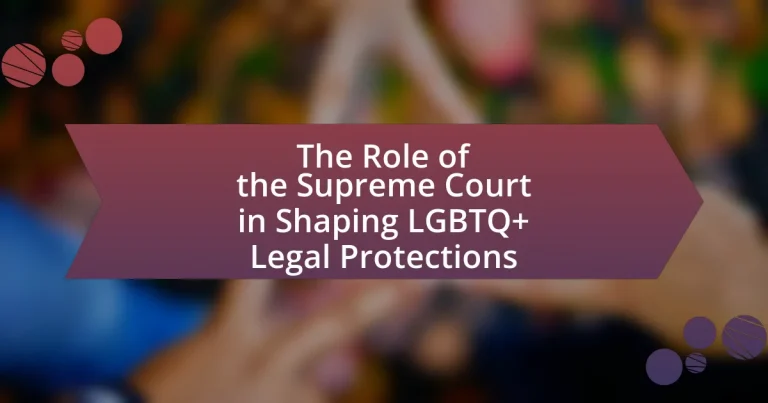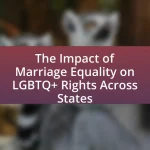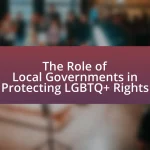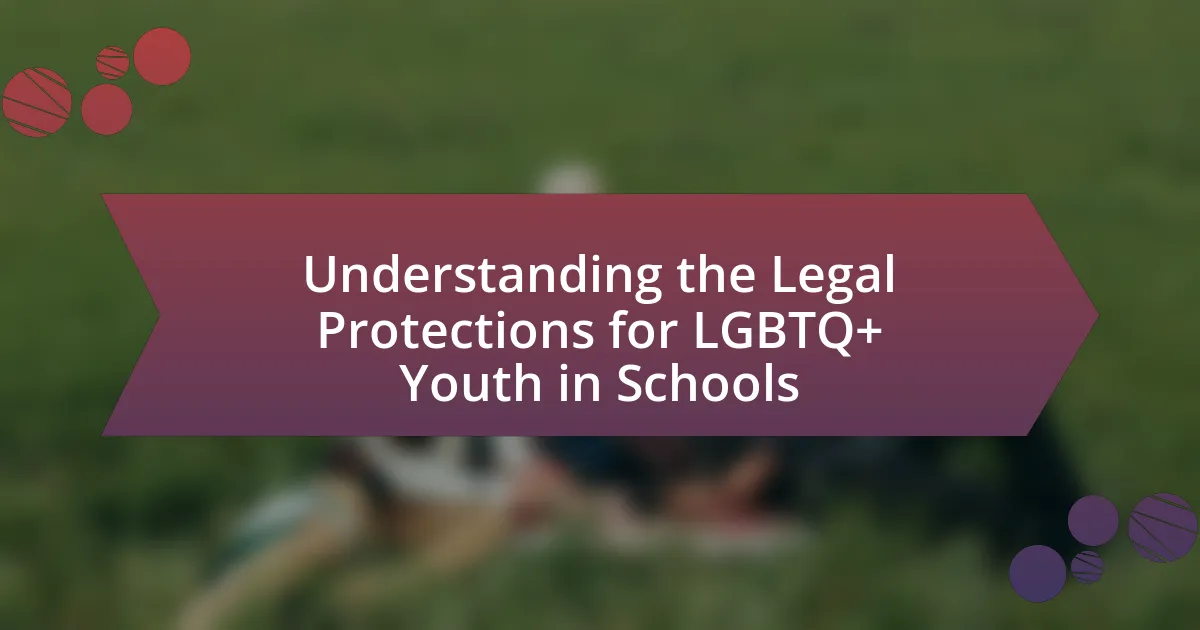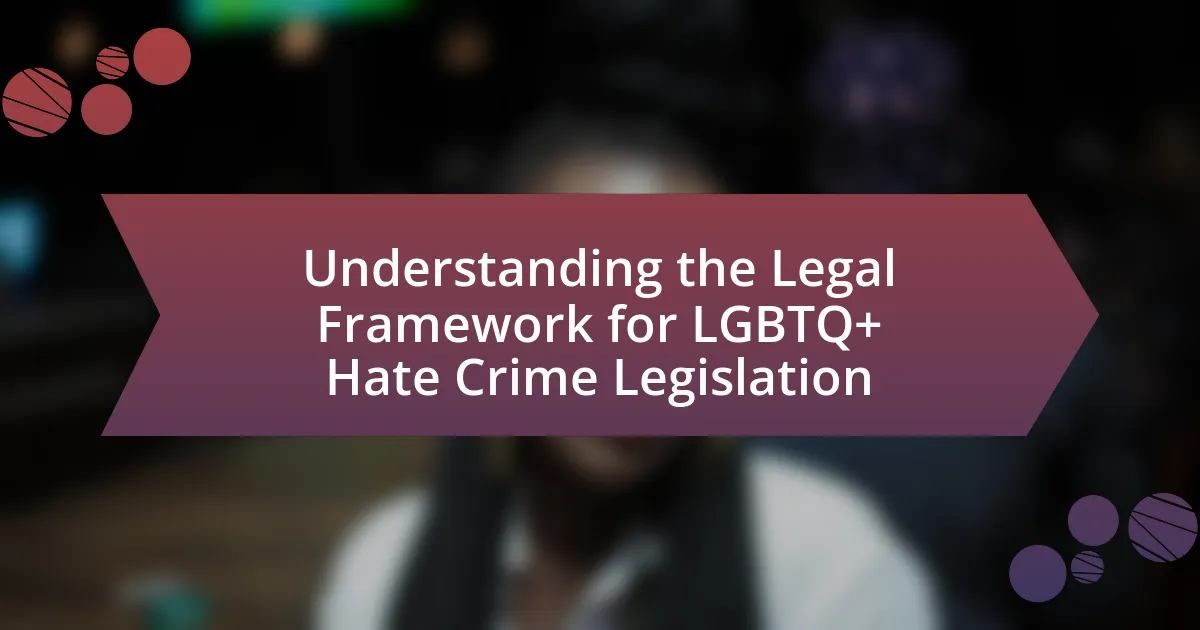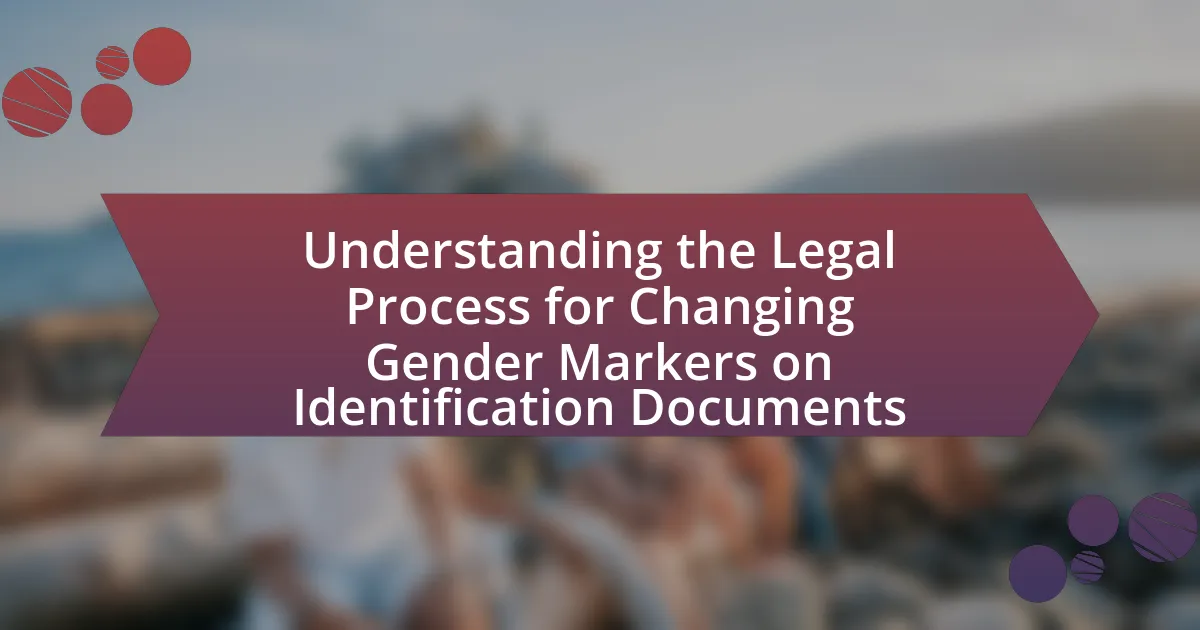The Supreme Court plays a pivotal role in shaping legal protections for LGBTQ+ individuals through its interpretation of the Constitution and federal laws. Landmark rulings such as Obergefell v. Hodges (2015) and Bostock v. Clayton County (2020) have established significant legal precedents, including the constitutional right to same-sex marriage and the prohibition of discrimination based on sexual orientation or gender identity in employment. The article examines the historical evolution of LGBTQ+ rights influenced by Supreme Court decisions, the impact of societal changes on these rulings, and the ongoing legal battles that reflect current debates surrounding LGBTQ+ issues. Additionally, it discusses the implications of these cases for future legal protections and the role of grassroots movements in advocating for LGBTQ+ rights.

What is the Role of the Supreme Court in Shaping LGBTQ+ Legal Protections?
The Supreme Court plays a crucial role in shaping LGBTQ+ legal protections by interpreting the Constitution and federal laws to extend civil rights to LGBTQ+ individuals. Landmark cases such as Obergefell v. Hodges (2015) established the constitutional right to same-sex marriage, affirming that denying this right violates the Equal Protection Clause. Additionally, in Bostock v. Clayton County (2020), the Court ruled that discrimination based on sexual orientation or gender identity constitutes sex discrimination under Title VII of the Civil Rights Act of 1964. These decisions demonstrate the Supreme Court’s influence in advancing legal protections for LGBTQ+ individuals and ensuring their rights are recognized under U.S. law.
How has the Supreme Court influenced LGBTQ+ rights over time?
The Supreme Court has significantly influenced LGBTQ+ rights through landmark rulings that have expanded legal protections and recognition. Notable cases include Obergefell v. Hodges (2015), where the Court ruled that same-sex marriage is a constitutional right under the Fourteenth Amendment, thereby legalizing it nationwide. Additionally, in Lawrence v. Texas (2003), the Court struck down sodomy laws, affirming the right to private consensual sexual conduct. These decisions reflect a broader trend of increasing recognition and protection of LGBTQ+ rights, demonstrating the Court’s pivotal role in shaping legal standards and societal acceptance over time.
What landmark cases have defined LGBTQ+ legal protections?
Landmark cases that have defined LGBTQ+ legal protections include Obergefell v. Hodges (2015), which legalized same-sex marriage nationwide, and Lawrence v. Texas (2003), which struck down sodomy laws, affirming the right to private sexual conduct. Additionally, United States v. Windsor (2013) invalidated the Defense of Marriage Act, ensuring federal recognition of same-sex marriages. These cases collectively established critical legal precedents that protect LGBTQ+ rights and affirm equality under the law.
How have societal changes impacted the Supreme Court’s decisions?
Societal changes have significantly influenced the Supreme Court’s decisions, particularly regarding LGBTQ+ legal protections. For instance, the increasing acceptance of LGBTQ+ individuals in society has led to landmark rulings such as Obergefell v. Hodges in 2015, which legalized same-sex marriage nationwide. This decision reflected a shift in public opinion, where support for same-sex marriage rose from 27% in 1996 to 70% in 2021, demonstrating how evolving societal norms can drive judicial outcomes. Additionally, cases like Lawrence v. Texas in 2003, which struck down sodomy laws, were also a response to changing attitudes towards LGBTQ+ rights, showcasing the Court’s responsiveness to the prevailing social climate.
What are the key legal principles established by the Supreme Court regarding LGBTQ+ rights?
The key legal principles established by the Supreme Court regarding LGBTQ+ rights include the recognition of same-sex marriage as a constitutional right, the prohibition of discrimination based on sexual orientation in employment, and the affirmation of the right to privacy in intimate relationships. In Obergefell v. Hodges (2015), the Court ruled that same-sex marriage is protected under the Fourteenth Amendment, ensuring marriage equality nationwide. Additionally, in Bostock v. Clayton County (2020), the Court held that Title VII of the Civil Rights Act of 1964 prohibits employment discrimination based on sexual orientation or gender identity, thereby extending workplace protections to LGBTQ+ individuals. These rulings collectively affirm the legal recognition and protection of LGBTQ+ rights in the United States.
What constitutional amendments are relevant to LGBTQ+ legal protections?
The constitutional amendments relevant to LGBTQ+ legal protections include the Fourteenth Amendment, which guarantees equal protection under the law, and the First Amendment, which protects freedom of speech and expression. The Fourteenth Amendment has been pivotal in cases such as Obergefell v. Hodges (2015), where the Supreme Court ruled that same-sex marriage is a constitutional right, affirming that denying marriage to same-sex couples violates the equal protection clause. The First Amendment has also been significant in protecting LGBTQ+ individuals’ rights to express their identities and advocate for their rights without government interference.
How do these legal principles affect state laws on LGBTQ+ issues?
Legal principles established by the Supreme Court significantly influence state laws on LGBTQ+ issues by setting binding precedents that states must follow. For example, the landmark case Obergefell v. Hodges (2015) legalized same-sex marriage nationwide, compelling states to recognize and uphold marriage equality. Additionally, rulings related to discrimination, such as Bostock v. Clayton County (2020), clarified that employment discrimination based on sexual orientation or gender identity is prohibited under Title VII of the Civil Rights Act, thereby affecting state employment laws. These Supreme Court decisions create a legal framework that states must adhere to, limiting their ability to enact laws that would infringe upon the rights of LGBTQ+ individuals.

What significant Supreme Court rulings have shaped LGBTQ+ legal protections?
Significant Supreme Court rulings that have shaped LGBTQ+ legal protections include Obergefell v. Hodges (2015), which legalized same-sex marriage nationwide, and Lawrence v. Texas (2003), which struck down sodomy laws, affirming the right to private sexual conduct. Obergefell v. Hodges established that same-sex couples have the fundamental right to marry, thereby ensuring equal legal recognition and benefits. Lawrence v. Texas invalidated laws criminalizing consensual same-sex relationships, reinforcing the principle of personal liberty and privacy. These rulings collectively advanced the legal status and rights of LGBTQ+ individuals in the United States.
What was the impact of Obergefell v. Hodges on same-sex marriage?
Obergefell v. Hodges legalized same-sex marriage nationwide in the United States, establishing it as a constitutional right under the Fourteenth Amendment. This landmark Supreme Court decision, issued on June 26, 2015, invalidated state bans on same-sex marriage and required all states to recognize marriages performed in other jurisdictions. The ruling significantly advanced LGBTQ+ legal protections by affirming that same-sex couples have the same legal rights and recognition as opposite-sex couples, thereby promoting equality and reducing discrimination in marriage laws across the country.
How did this ruling change the legal landscape for same-sex couples?
The ruling significantly expanded legal recognition and protections for same-sex couples by affirming their right to marry nationwide. This landmark decision, issued by the Supreme Court in Obergefell v. Hodges in 2015, established that state bans on same-sex marriage were unconstitutional under the Fourteenth Amendment, thereby ensuring that same-sex couples have the same legal rights and benefits as heterosexual couples. The ruling not only legalized same-sex marriage across all states but also set a precedent for future cases involving LGBTQ+ rights, reinforcing the principle of equality under the law.
What were the dissenting opinions in this case, and what do they signify?
The dissenting opinions in this case highlighted concerns regarding the implications of the majority ruling on religious freedoms and state rights. Dissenters argued that the decision undermined the balance between individual liberties and the rights of businesses to operate according to their beliefs. This signifies a deep division within the Court on how to interpret constitutional protections, particularly in relation to LGBTQ+ rights versus religious expression. The dissenting opinions reflect a cautionary stance, emphasizing the potential for the ruling to set a precedent that could limit religious freedoms in future cases involving LGBTQ+ issues.
How did Lawrence v. Texas influence LGBTQ+ rights regarding privacy?
Lawrence v. Texas significantly advanced LGBTQ+ rights regarding privacy by invalidating state laws that criminalized consensual same-sex sexual conduct. The Supreme Court’s 2003 decision emphasized the constitutional right to privacy, asserting that intimate consensual conduct is part of the liberty protected by the Due Process Clause of the Fourteenth Amendment. This ruling overturned the precedent set by Bowers v. Hardwick in 1986, which upheld such laws, thereby affirming that individuals have the right to engage in private sexual conduct without government interference. The Court’s recognition of privacy rights in Lawrence v. Texas laid the groundwork for subsequent legal advancements in LGBTQ+ rights, including marriage equality, by establishing a legal framework that protects personal autonomy and intimate relationships.
What legal precedents were overturned by this ruling?
The ruling overturned the legal precedents established in Bowers v. Hardwick (1986) and Obergefell v. Hodges (2015). Bowers v. Hardwick upheld the constitutionality of state laws criminalizing homosexual conduct, while Obergefell v. Hodges recognized the right to same-sex marriage. The recent ruling effectively invalidated these precedents, reshaping the legal landscape for LGBTQ+ rights and protections.
How has this decision been applied in subsequent cases?
The decision has been applied in subsequent cases by establishing precedents that reinforce LGBTQ+ rights and protections under the law. For instance, the ruling in Obergefell v. Hodges (2015), which legalized same-sex marriage nationwide, drew heavily on principles established in earlier cases like Lawrence v. Texas (2003), which invalidated sodomy laws and affirmed the dignity of LGBTQ+ individuals. Additionally, in Bostock v. Clayton County (2020), the Supreme Court ruled that discrimination based on sexual orientation or gender identity constitutes sex discrimination under Title VII of the Civil Rights Act, further extending protections established in prior rulings. These applications demonstrate a consistent judicial trend towards recognizing and safeguarding LGBTQ+ rights in various legal contexts.

What challenges does the Supreme Court face in advancing LGBTQ+ legal protections?
The Supreme Court faces significant challenges in advancing LGBTQ+ legal protections, primarily due to ideological divisions among justices and varying interpretations of constitutional rights. These ideological splits can lead to inconsistent rulings, as seen in cases like Obergefell v. Hodges, which legalized same-sex marriage, versus more recent cases where the Court has been less favorable towards LGBTQ+ rights. Additionally, the lack of comprehensive federal legislation protecting LGBTQ+ individuals from discrimination complicates the Court’s ability to establish uniform legal standards. The Court’s reliance on existing laws, such as the Civil Rights Act, which does not explicitly mention sexual orientation or gender identity, further limits its capacity to expand protections. These factors create a complex legal landscape that hinders the advancement of LGBTQ+ rights through judicial means.
What are the current legal battles involving LGBTQ+ rights before the Supreme Court?
The current legal battles involving LGBTQ+ rights before the Supreme Court include cases addressing the rights of LGBTQ+ individuals in employment, healthcare, and education. One significant case is 303 Creative LLC v. Elenis, which examines whether a web designer can refuse to create wedding websites for same-sex couples based on religious beliefs. Another important case is the challenge to the Biden administration’s interpretation of Title IX, which prohibits discrimination based on sex and has implications for transgender students’ rights in schools. These cases reflect ongoing debates about the balance between religious freedom and anti-discrimination protections for LGBTQ+ individuals.
How do these cases reflect ongoing societal debates about LGBTQ+ issues?
These cases reflect ongoing societal debates about LGBTQ+ issues by highlighting the tension between legal recognition and societal acceptance. For instance, landmark Supreme Court decisions, such as Obergefell v. Hodges in 2015, which legalized same-sex marriage, illustrate the clash between evolving legal standards and persistent cultural opposition. This case underscored the struggle for equal rights, revealing deep divisions in public opinion, as polls indicated that while support for same-sex marriage has increased, significant portions of the population still oppose it based on religious or traditional beliefs. Additionally, cases like Masterpiece Cakeshop v. Colorado Civil Rights Commission in 2018 demonstrate the ongoing debate over religious freedom versus anti-discrimination protections, reflecting broader societal conflicts regarding the rights of LGBTQ+ individuals versus the rights of those who oppose LGBTQ+ recognition on moral grounds. These legal battles serve as a microcosm of the larger societal discourse surrounding LGBTQ+ rights, illustrating how judicial decisions can both influence and reflect public attitudes.
What implications do these cases have for future legal protections?
The implications of these cases for future legal protections include the establishment of precedents that strengthen the legal framework for LGBTQ+ rights. For instance, rulings that affirm anti-discrimination protections in employment and housing set a legal standard that can be referenced in future cases, thereby expanding protections against discrimination based on sexual orientation and gender identity. Additionally, these cases signal to lower courts and legislatures the importance of upholding and advancing LGBTQ+ rights, potentially influencing future legislation aimed at enhancing legal protections. The Supreme Court’s decisions also reflect societal shifts towards greater acceptance of LGBTQ+ individuals, which can lead to more robust legal safeguards in the future.
How can individuals advocate for LGBTQ+ legal protections in light of Supreme Court rulings?
Individuals can advocate for LGBTQ+ legal protections by engaging in grassroots activism, lobbying lawmakers, and participating in public awareness campaigns. Grassroots activism involves organizing or joining local groups that focus on LGBTQ+ rights, which can amplify voices and influence public opinion. Lobbying lawmakers includes contacting representatives to express support for legislation that protects LGBTQ+ individuals, such as the Equality Act, which aims to prohibit discrimination based on sexual orientation and gender identity. Public awareness campaigns can be executed through social media, educational events, and community outreach to inform others about the importance of legal protections for LGBTQ+ individuals, especially in light of recent Supreme Court rulings that may impact these rights. For instance, the Supreme Court’s decision in Bostock v. Clayton County (2020) affirmed that Title VII of the Civil Rights Act protects employees from discrimination based on sexual orientation or gender identity, highlighting the need for continued advocacy to ensure these protections are upheld and expanded.
What strategies can be employed to influence public opinion and policy?
Strategies to influence public opinion and policy include advocacy campaigns, public education initiatives, and coalition building. Advocacy campaigns utilize social media and traditional media to raise awareness and mobilize support for specific issues, such as LGBTQ+ rights, effectively shaping public perception. Public education initiatives, like workshops and informational sessions, inform the community about legal protections and rights, fostering a more informed electorate. Coalition building among diverse groups amplifies voices and creates a united front, increasing the likelihood of policy change. Historical examples, such as the successful campaigns for marriage equality in the United States, demonstrate how these strategies can lead to significant shifts in both public opinion and legal frameworks.
How can grassroots movements impact future Supreme Court decisions?
Grassroots movements can significantly influence future Supreme Court decisions by mobilizing public opinion and advocating for legal changes. These movements often raise awareness about specific issues, such as LGBTQ+ rights, which can lead to increased societal pressure on lawmakers and the judiciary. For instance, the grassroots efforts surrounding marriage equality contributed to the Supreme Court’s decision in Obergefell v. Hodges (2015), which legalized same-sex marriage nationwide. This demonstrates that organized advocacy can shape the legal landscape by highlighting the need for judicial recognition of marginalized rights, ultimately affecting the Court’s rulings and interpretations of the law.
